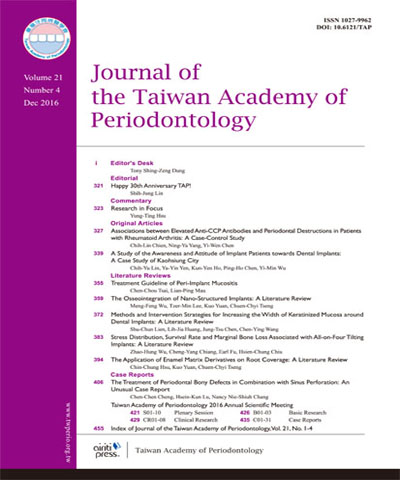
臺灣牙周病醫學會雜誌/Journal of The Taiwan Academy of Periodontology
臺灣牙周病醫學會,正常發行
選擇卷期
- 期刊
Background: Due to the high success rate and high survival rate of dental implants, dental implant had become a choice in dental treatment. Immediate implant compared to traditional implant surgery could reduce the frequency and shorten the overall treatment time, but also increased the surgical potential risks, such as sinus perforation, lingual plate perforating and inferior alveolar nerve damage. In this study, we clarified the morphology of the mandible, and identified the relationship between the location of the mandibular lingual concavity and the inferior alveolar canal for risk assessment of inferior alveolar nerve damage by using computerized tomography.Materials and Methods: Series cross-sectional computed tomography images were analyzed. Two horizontal imaginary line 2 mm above and top of inferior alveolar nerve canal (IAC), and two imaginary points the most bumps and the most concaved point of lingual plate as were used as reference, we analyzed the morphology of mandible and distance from root tip to the inferior alveolar nerve (RAC). In terms of the undercut type, we further measured the depth, height, angle of the lingual concavity, the relationship between the lingual concavity and IAC, and the potential risk of inferior alveolar nerve injury.Results: A total of 57 patients, including 39 males and 18 females (217 teeth), with mean age of 45.5 ± 17 years, are included in this study. The results show that the most prevalent morphology of mandible in posterior area is U type. The prevalence of lingual concavity is 56.2%, and the average RAC is 6.2 ± 2.6 mm. Further analysis of the undercut type, the average concavity depth, concavity height, and angle is 5.9 ± 2.2 mm, 10.6 ± 2.9 mm, and 61.4 ± 8.1°, respectively. The majority of teeth are located in area C (54.1%) in terms of the relationship of the location of the lingual concavity and the inferior alveolar canal. The incidence of nerve damage from mandibular secondary premolar to secondary molar is 44.9%, 26.6% and 71.9%, respectively.Conclusions: The concave morphology of the mandible in Taiwanese is most prevalent, and the RAC was varied in different teeth type. To increase the safety and success rate of immediate implant placement, carefully evaluate the anatomical features of implant sites in the mandibular posterior area were essential.
- 期刊
侵犯性牙周炎患者同時受到致病性病原體以及病患本身高感受性的影響,導致牙周組織迅速破壞,臨床上需要透過詳細檢測與病史追蹤得到確切診斷,進一步謹慎訂定治療計畫與跨科協同溝通,才能達到長期穩定的療效。本病例報告提出一位29歲廣泛型嚴重侵犯性牙周炎之女性患者,求診時發現口內多處嚴重骨缺損與牙周破壞,前牙產生病理性位移,透過臨床檢查與診斷,適當輔助系統性抗生素進行初期牙周治療與引導組織再生手術,牙周健康狀況維持穩定後,透過矯正介入關閉齒間縫隙,改善齒列排列,16年長期追蹤下,病患執行良好口腔衛生及定期牙周維持性治療,維持治療之結果。
- 期刊
矯正之臨時錨定裝置廣泛應用於矯正治療中充當絕對錨定,而臨時錨定裝置植入處的皮質骨厚度會影響迷你骨釘的初期穩定性及其成功率。此篇文章的目的為蒐集東、西方人相關的皮質骨厚度資料,並比較東、西方人皮質骨厚度的差異性,以做為臨床上選擇矯正錨定的參考。分析結果顯示不同種族間皮質骨厚度因病患來源、測量的工具、方式與部位的不同,導致量測結果多所差異。在大部分的研究中,上、下顎之皮質骨厚度至少都有1毫米;然而,在前牙區也有少數測量結果顯示皮質骨厚度不足1 毫米。性別與年齡對皮質骨厚度的影響上,不同性別中,皮質骨厚度並沒有顯著差別;而在某些研究中,不同年齡層的皮質骨厚度有顯著差異。綜合東、西方人的研究,上、下顎比較方面,下顎後牙頰側區之皮質骨厚度較上顎後牙頰側區厚;前牙區則無一致的結果。前、後牙比較方面,在下顎後牙區皮質骨較前牙區厚,在上顎則無明顯差別。此篇文章顯示東方人及西方人皮質骨厚度的差異,並整理出不同種族的不同部位之皮質骨厚度的數據,做為臨床上放置迷你骨釘的參考。
- 期刊
牙周病患同時多處患有不適合的義齒及根尖病變進行全口重建時往往是臨床上一大挑戰。本病例報告為一跨科合作之整體治療病例。病患治療涵蓋傳統牙周手術,包括上顎前牙區牙冠增長術合併軟組織擴增術,以及上顎左側後牙區放置自體移植骨的牙周再生術。除此之外,大型根尖病變處給予接受根尖手術合併引導骨再生術;並於缺牙區進行植牙手術合併骨嵴撐開術與引導骨再生術,最後以固定假牙復形。手術1年後進行追蹤,全口牙周探測深度皆為3毫米以內,手術區有牙周附連獲得,大型根尖病灶區顯示完全骨充填,植牙區周圍骨高度穩定,前牙達到美觀之修復。本病例報告結果顯示合併牙髓病、牙周病與贋復等問題的複雜病例藉由跨科合作之整合治療可以有效的達到的全口重建目的。
- 期刊
牙周病不僅會造成牙齦發炎腫脹,牙齒周圍骨頭破壞,嚴重者更會使牙齒動搖、喪失,影響患者咬合及美觀。本文提出一38歲,患有廣泛性中、重度慢性牙周炎男性患者的牙周整體治療病例。治療前有廣泛性牙齦發炎,多顆牙有5到10毫米之牙周囊袋探測深度,並有嚴重骨內缺損。病患經過牙周基本治療及牙周手術治療,包括利用人工合成骨合併膠原蛋白可吸收性再生膜進行引導組織再生術,或使用人工合成骨合併牙釉基質衍生物輔助牙周再生。術後一年的臨床結果顯示,83%的全口牙周囊袋探測深度在3毫米以內,13%的區域得到3 ~ 6毫米之附連獲得,骨內缺損皆有放射性骨充填及骨密度增加。雖有部分預後狀況不佳的牙齒經患者堅持下保留,經牙周治療後狀況改善但較不明確,然而患者如能保持良好之口腔衛生並定期接受牙周支持性治療,整體的牙周預後可維持良好且效果穩定。
- 期刊
本文提出一個逆行性植體周圍炎(retrograde peri-implantitis)的病例報告,54歲男性病患在右下第一、第二大臼齒區域植牙後,出現右下第二小臼齒及右下第一大臼齒植牙處的牙齦腫脹、疼痛。X光片上可以發現右下第一大臼齒植體根尖及鄰牙有放射線透射區,經診斷為逆行性植體周圍炎。在移除鄰牙斷裂的牙根,多次的手術清創及引導骨再生術後仍然無法控制發炎破壞,最後移除感染的植體、清創,等傷口癒合後,重新植入植體,最後臨床得到一個穩定的結果。提出本病例是希望藉由病例分析,探討可能造成逆行性植體周圍炎的病因及相關的治療方式。

